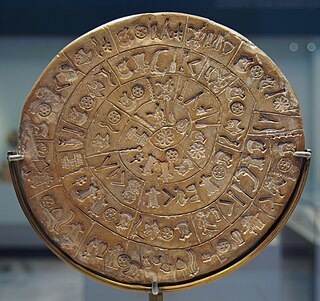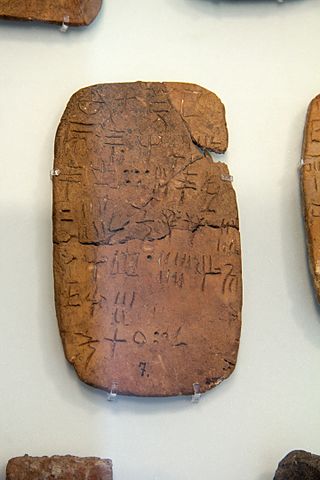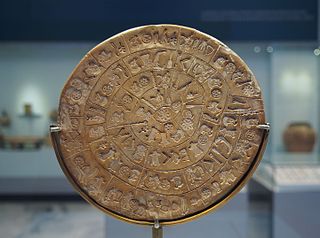In philology, decipherment is the discovery of the meaning of texts written in ancient or obscure languages or scripts. [1]
In a few cases, a multilingual artifact has been necessary to facilitate decipherment, the Rosetta Stone being the classic example. Statistical techniques provide another pathway to decipherment, as does the analysis of modern languages derived from ancient languages in which undeciphered texts are written. Archaeological and historical information is helpful in verifying hypothesized decipherments.

Linear A is a writing system that was used by the Minoans of Crete from 1800 BC to 1450 BC. Linear A was the primary script used in palace and religious writings of the Minoan civilization. It was succeeded by Linear B, which was used by the Mycenaeans to write an early form of Greek. It was discovered by the archaeologist Sir Arthur Evans in 1900. No texts in Linear A have yet been deciphered. Evans named the script "Linear" because its characters consisted simply of lines inscribed in clay, in contrast to the more pictographic characters in Cretan hieroglyphs that were used during the same period.

Linear B is a syllabic script that was used for writing in Mycenaean Greek, the earliest attested form of the Greek language. The script predates the Greek alphabet by several centuries, the earliest known examples dating to around 1400 BC. It is adapted from the earlier Linear A, an undeciphered script potentially used for writing the Minoan language, as is the later Cypriot syllabary, which also recorded Greek. Linear B, found mainly in the palace archives at Knossos, Kydonia, Pylos, Thebes and Mycenae, disappeared with the fall of Mycenaean civilization during the Late Bronze Age collapse. The succeeding period, known as the Greek Dark Ages, provides no evidence of the use of writing.

Writing is the act of creating a persistent representation of human language. A writing system uses a set of symbols and rules to encode aspects of spoken language, such as its lexicon and syntax. However, written language may take on characteristics distinct from those of any spoken language.

Egyptian hieroglyphs were the formal writing system used in Ancient Egypt for writing the Egyptian language. Hieroglyphs combined logographic, syllabic and alphabetic elements, with more than 100 distinct characters. Cursive hieroglyphs were used for religious literature on papyrus and wood. The later hieratic and demotic Egyptian scripts were derived from hieroglyphic writing, as was the Proto-Sinaitic script that later evolved into the Phoenician alphabet. Through the Phoenician alphabet's major child systems, the Egyptian hieroglyphic script is ancestral to the majority of scripts in modern use, most prominently the Latin and Cyrillic scripts and the Arabic script, and possibly the Brahmic family of scripts.

The Phaistos Disc or Phaistos Disk is a disk of fired clay from the island of Crete, Greece, possibly from the middle or late Minoan Bronze Age, bearing a text in an unknown script and language. Its purpose and its original place of manufacture remain disputed. It is now on display at the archaeological museum of Heraklion. The name is sometimes spelled Phaestos or Festos.

The Cypriot or Cypriote syllabary is a syllabic script used in Iron Age Cyprus, from about the 11th to the 4th centuries BCE, when it was replaced by the Greek alphabet. It has been suggested that the script remained in use as late as the 1st century BC. A pioneer of that change was King Evagoras of Salamis. It is thought to be descended from the Cypro-Minoan syllabary, itself a variant or derivative of Linear A. Most texts using the script are in the Arcadocypriot dialect of Greek, but also one bilingual inscription was found in Amathus.

The Minoan language is the language of the ancient Minoan civilization of Crete written in the Cretan hieroglyphs and later in the Linear A syllabary. As the Cretan hieroglyphs are undeciphered and Linear A only partly deciphered, the Minoan language is unknown and unclassified; with the existing evidence, it is impossible to be certain that the two scripts record the same language.

Anatolian hieroglyphs are an indigenous logographic script native to central Anatolia, consisting of some 500 signs. They were once commonly known as Hittite hieroglyphs, but the language they encode proved to be Luwian, not Hittite, and the term Luwian hieroglyphs is used in English publications. They are typologically similar to Egyptian hieroglyphs, but do not derive graphically from that script, and they are not known to have played the sacred role of hieroglyphs in Egypt. There is no demonstrable connection to Hittite cuneiform.

Eteocypriot is an extinct non-Indo-European language that was spoken in Cyprus by a non-Hellenic population during the Iron Age. The name means "true" or "original Cypriot" parallel to Eteocretan, both of which names are used by modern scholars to mean the non-Greek languages of those places. Eteocypriot was written in the Cypriot syllabary, a syllabic script derived from Linear A. The language was under pressure from Arcadocypriot Greek from about the 10th century BC and finally became extinct in about the 4th century BC.

The Byblos script, also known as the Byblos syllabary, Pseudo-hieroglyphic script, Proto-Byblian, Proto-Byblic, or Byblic, is an undeciphered writing system, known from ten inscriptions found in Byblos, a coastal city in Lebanon. The inscriptions are engraved on bronze plates and spatulas, and carved in stone. They were excavated by Maurice Dunand, from 1928 to 1932, and published in 1945 in his monograph Byblia Grammata. The inscriptions are conventionally dated to the second millennium BC, probably between the 18th and 15th centuries BC.

Many people have claimed to have deciphered the Phaistos Disc.
The Cypro-Minoan syllabary (CM), more commonly called the Cypro-Minoan Script, is an undeciphered syllabary used on the island of Cyprus and at its trading partners during the late Bronze Age and early Iron Age. The term "Cypro-Minoan" was coined by Arthur Evans in 1909 based on its visual similarity to Linear A on Minoan Crete, from which CM is thought to be derived. Approximately 250 objects—such as clay balls, cylinders, and tablets which bear Cypro-Minoan inscriptions, have been found. Discoveries have been made at various sites around Cyprus, as well as in the ancient city of Ugarit on the Syrian coast. It is thought to be somehow related to the later Cypriot syllabary.

Hieroglyphic Luwian (luwili) is a variant of the Luwian language, recorded in official and royal seals and a small number of monumental inscriptions. It is written in a hieroglyphic script known as Anatolian hieroglyphs.
Mesoamerica, along with Mesopotamia and China, is one of three known places in the world where writing is thought to have developed independently. Mesoamerican scripts deciphered to date are a combination of logographic and syllabic systems. They are often called hieroglyphs due to the iconic shapes of many of the glyphs, a pattern superficially similar to Egyptian hieroglyphs. Fifteen distinct writing systems have been identified in pre-Columbian Mesoamerica, many from a single inscription. The limits of archaeological dating methods make it difficult to establish which was the earliest and hence the progenitor from which the others developed. The best documented and deciphered Mesoamerican writing system, and the most widely known, is the classic Maya script. Earlier scripts with poorer and varying levels of decipherment include the Olmec hieroglyphs, the Zapotec script, and the Isthmian script, all of which date back to the 1st millennium BC. An extensive Mesoamerican literature has been conserved, partly in indigenous scripts and partly in postconquest transcriptions in the Latin script.

In epigraphy, a multilingual inscription is an inscription that includes the same text in two or more languages. A bilingual is an inscription that includes the same text in two languages. Multilingual inscriptions are important for the decipherment of ancient writing systems, and for the study of ancient languages with small or repetitive corpora.

Many undeciphered writing systems exist today; most date back several thousand years, although some more modern examples do exist. The term "writing systems" is used here loosely to refer to groups of glyphs which appear to have representational symbolic meaning, but which may include "systems" that are largely artistic in nature and are thus not examples of actual writing.

A writing system comprises a particular set of symbols, called a script, as well as the rules by which the script represents a particular language. Writing systems can generally be classified according to how symbols function according to these rules, with the most common types being alphabets, syllabaries, and logographies. Alphabets use symbols called letters that correspond to spoken phonemes. Abjads generally only have letters for consonants, while pure alphabets have letters for both consonants and vowels. Abugidas use characters that correspond to consonant–vowel pairs. Syllabaries use symbols called syllabograms to represent syllables or moras. Logographies use characters that represent semantic units, such as words or morphemes.

Jan Gijsbert Pieter Best is a Dutch pre- and protohistorian, comparative linguist, archaeologist, and author. For about 30 years, he was Professor at the University of Amsterdam, where he taught ancient history, and Mediterranean prehistory and protohistory.

Frederik Christiaan Woudhuizen was a Dutch independent scholar who studied ancient Indo-European languages, hieroglyphic Luvian/Luwian, and Mediterranean protohistory. He was the former editor of Talanta, Proceedings of the Dutch Archaeological and Historical Society.